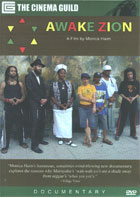
Awake Zion 2006
Distributed by Cinema Guild, 115 West 30th Street, Suite 800, New York, NY 10001; 212-685-6242
Produced by Twin Goat Productions
Directed by Monica Haim
DVD, color, 60 min.
College - Adult
African Studies, Jewish Studies, Religious Studies, Multicultural Studies, American Studies
Date Entered: 05/04/2007
Reviewed by Dan DiLandro, E.H. Butler Library, State University of New York College at BuffaloWhile any common thread between Rastafarianism and Judaism might be difficult to find, filmmaker Monica Haim attempts to establish just such a common ground, exploring the roots of Rasta and reggae music and their intersection with Jewish philosophy and present-day thought in her Awake Zion.
The fact that the film’s title is lifted from the lyrics of a reggae song is, in itself, somewhat surprising. Indeed, Haim cites many instances of seemingly exclusive Judaic references in reggae and Rasta throughout the film. For example, references to biblical Zion and other concepts as well as physical similarities, such as the prevalence of the Star of David motif and dictates regarding personal grooming, are common to both Judaism and Rastafarianism. Haim builds a case for the borrowing of Jewish thought and history by Rasta and reggae by citing Jewish rabbis as well as experts on Rastafarianism, music, and pop-culture.
Unfortunately for the film’s thesis, the expert rabbi can only concede that there is nothing essentially hostile to traditional Jewish though in Rastafarianism – not, as viewer might hope, that there exist any sort of exact parallels or precise proof of borrowing from Judaism. The rabbi cites traditions regarding the cultural exchange between King Solomon’s Judah and the Queen of Sheba’s Ethiopia and the film touches upon the tale that Solomon sired a son by the African Queen – but none of this tantalizing proof is explored to any real depth. The filmmaker takes some Jamaican Rastafarians to a local synagogue, where the latter marvel especially at the central Star of David, expressing that they had thought that “it was their symbol.” Indeed, it is interesting to speculate upon how the Star became popular in Rastafarianism, but the narrative generally excludes incisive historical research or oral traditional knowledge in making its point. Ultimately, the filmmaker concludes that “Soon it became less about finding the actual connection and more about the experience itself.”
The lack of “real” history undercuts the film. So much of the narrative revolves around how people “feel”: Haim’s Jewish grandmother seems to like listening to reggae and responds well to the lyrics’ mention of “Israelis”; both movements quote from the Old Testament; Israelis themselves speak of “relating” to Rasta “energy,” but do not betray any sense of kinship to the music or philosophy; others express common themes between the two cultures, the slavery and oppression undergone by both exiled Jews and African slaves alike…. The fact that “words, sound, and power” are recommended in both Judaic and Rastafari enunciation, speech, and music makes for very shaky ground on which to insist upon a deeper, identical origin. Oftentimes, in fact, one would be able to correlate any culture with Judiasm, Rasta, or both: Many individuals in contemporary American society cite passages from the Old Testament, but would doubtlessly not self-identify as Jews. Some subjects note that neither Solomon nor Rastafarians cut their hair, but like the commonality of the Star of David motif and artwork, no proof is offered for why this might be. The most coherent reasoning regarding cultural similarities involves Solomon and Sheba’s African lineage descended to Haile Selassie, titularly the “Lion of Judah” and the more recent Ethiopian emperor’s adoption by the Rasta movement. Marcus Garvey’s thoughts – mostly his “Back to Africa” movement and his prediction of a great African King – are touched upon; but it is impossible on the basis of the narrative to determine how exactly these themes developed into the Rastafarian philosophy. Speculation that Rastafarians are descendants of Israel’s Lost Tribes is certainly interesting, but not explored, much less proven.
Indeed, Selassie’s “foster son” (though whether he was adopted by the late emperor is entirely unclear) married a Jewish woman, but the most evocative point raised is that he ignored her Jewish background. The narrative makes no case for any parallels between her culture and Rasta. His wife emotes that she likes Rastafarianism.
The documentary ends with Haim explaining that she didn’t search to provide connections to the two cultures, but to “enjoy” seeing cultural borrowing in action. The idea that we’re all really the same underneath is an important lesson, but really undercuts the premise and promise of the film itself. Providing truly beautiful shots, especially of Jamaica, but also of Israel and the inner-city United States, the frequent marijuana use and chapter on “herb” might turn off some audiences that might otherwise be interested by the film’s travelogue elements. While Awake Zion might provide passing interest for students of Rastafarianism, it is not recommended for general anthropology collections or those that emphasize African, American, Jewish, or multicultural studies.
Awards
- Closing Night Film, Margaret Mead Film Festival, 2005
- Honorable Mention, Best Documentary Short, Black Point Film Fest, 2005